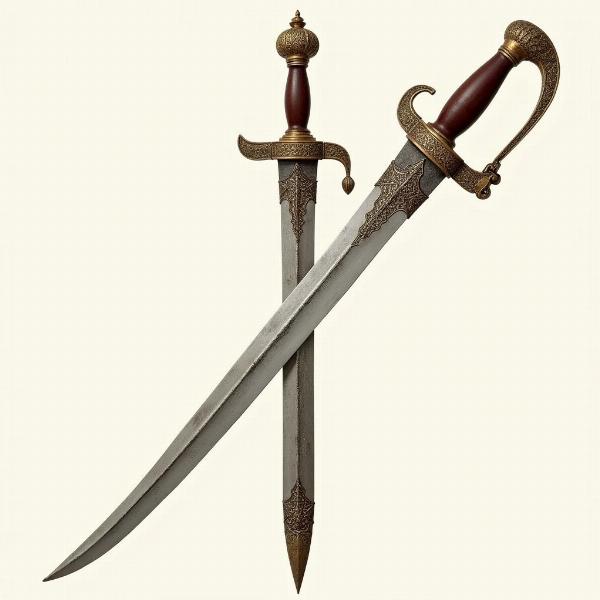Understanding the meaning of “katare” in Hindi is crucial for anyone navigating the rich tapestry of the language. This guide delves into the various interpretations, nuances, and cultural contexts associated with this word, providing a comprehensive understanding of its usage. Whether you’re a language enthusiast, a translator, or simply curious about Hindi vocabulary, this article will equip you with the knowledge you need.
Decoding “Katare”: Meanings and Contexts
“Katare” (कटारे) in Hindi primarily refers to daggers or small swords. It’s a term often found in historical texts, literature, and even everyday conversations, particularly when discussing ancient weaponry or symbolic representations of power and protection. However, the meaning can subtly shift depending on the context.
-
Weaponry: The most common meaning of “katare” is a dagger, a short-bladed weapon used for stabbing. Historically, katare were often ornate and carried by warriors and royalty. They symbolized strength, courage, and even divine power in certain contexts.
-
Symbolic Representation: Beyond its literal meaning, “katare” can also symbolize danger, betrayal, or hidden threats. In literature and folklore, it’s sometimes used metaphorically to represent a sharp tongue or cutting words.
-
Regional Variations: Like many Hindi words, the precise meaning and usage of “katare” can vary slightly across different regions of India. While the core meaning remains consistent, local dialects might have specific connotations or related terms.
 Katare Dagger in Hindi Culture
Katare Dagger in Hindi Culture
Katare in History and Culture
Katare hold a significant place in Indian history and culture. They were not merely weapons but often considered objects of art, adorned with precious stones and intricate carvings.
-
Royal Insignia: Katare were frequently part of royal regalia, signifying the ruler’s authority and martial prowess. They were often presented as gifts to honored guests and allies.
-
Ritualistic Significance: In some traditions, katare played a role in religious ceremonies and rituals. They were sometimes associated with deities representing power and protection.
“Katare” vs. Other Weaponry Terms
Understanding the distinction between “katare” and other similar terms is essential for accurate usage.
-
Khanjar: While both are daggers, “khanjar” usually denotes a curved blade, while “katare” typically refers to a straight-bladed dagger.
-
Chhura: This term is more general and can encompass various types of knives, including daggers. “Katare” is a more specific term referring to a particular type of dagger.
Using “Katare” in Modern Hindi
While less common than in historical contexts, “katare” still finds its place in contemporary Hindi.
-
Literary Usage: Authors and poets continue to use “katare” to evoke imagery of ancient battles, royal courts, or symbolic threats.
-
Figurative Language: In everyday conversations, you might hear someone use “katare” metaphorically to describe sharp words or a cutting remark. For example, “Uske shabd katare ki tarah the” (His words were like daggers).
How to pronounce “Katare” Correctly
The pronunciation of “katare” is relatively straightforward:
- Ka: Pronounced like the “cu” in “cut.”
- Ta: Pronounced like the “t” in “top.”
- Re: Pronounced like the “ray” in “ray of sunshine.”
Conclusion
“Katare,” a word steeped in history and cultural significance, continues to resonate in the Hindi language. From its literal meaning as a dagger to its symbolic representation of power and danger, understanding the nuances of “katare” enriches one’s appreciation of Hindi literature, history, and everyday conversations.
FAQ
-
What is the primary meaning of “katare”? The primary meaning of “katare” is a dagger, a short-bladed weapon used for stabbing.
-
Does “katare” have any symbolic meanings? Yes, “katare” can symbolize danger, betrayal, or sharp words.
-
How is “katare” different from “khanjar”? “Khanjar” usually refers to a curved dagger, while “katare” typically denotes a straight-bladed dagger.
-
Is “katare” still used in modern Hindi? Yes, it is used in literature, figurative language, and sometimes in everyday conversations.
-
How do you pronounce “katare”? It’s pronounced with the “ka” as in “cut,” “ta” as in “top,” and “re” as in “ray.”
-
What is the historical significance of katare? Katare were often part of royal regalia and sometimes used in religious ceremonies.
-
Can you give an example of “katare” used metaphorically? “Uske shabd katare ki tarah the” (His words were like daggers).
Meaning-Hindi.in is your premier resource for professional Hindi translation services. Specializing in business, legal, technical, website, educational, and specialized translations, we offer accurate and culturally sensitive language solutions. Our expertise in Hindi linguistics and cultural nuances ensures your message resonates effectively with your target audience. Whether you need quick turnaround times or specialized industry knowledge, Meaning-Hindi.in is here to help. Contact us today at [email protected] or +91 11-4502-7584. Let Meaning-Hindi.in bridge the language gap for you.